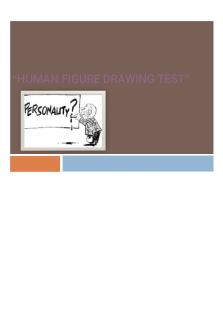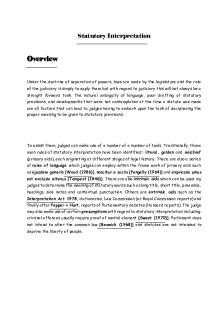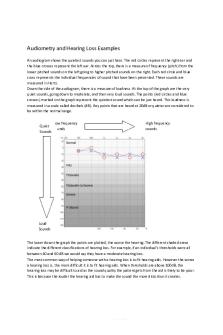511089323 Emotional Profile Index Interpretation PDF

| Title | 511089323 Emotional Profile Index Interpretation |
|---|---|
| Course | Intro to Psychology |
| Institution | San José State University |
| Pages | 9 |
| File Size | 287.8 KB |
| File Type | |
| Total Downloads | 12 |
| Total Views | 134 |
Summary
hello...
Description
EMOTIONAL PROFILE INDEX
Administration
Can be administered to individuals or to groups The inventory is given to the subjects who are told to provide the information requested on the top of the front page; namely name, date, age, sex, marital status, education completed and occupation Subjects should then be told to read the directions on the front page and the definitions of the trait terms The instruction simply requests the individual to circle the word in each pair which describes him best. When this is done, subject should be asked if they have any questions and these should be answered. Then may then begin. No time limit The test is usually completed in about 10-15 minutes In some cases where individuals have difficulty reading the test, or making their choices, the examiner should read each pair of the items to the subject and encourage him to make the choices.
SCORING
TO Obtain the raw score for the first emotion dimension, merely count the number of circles in column 1 which have been CHECKED. This, Then, is the raw score of the first emotion (Trustful) and is entered in the indicated box at the end of the test. this process is repeated for the 8 columns
If the subject has inadvertently- skipped one of two pairs, you may toss a coin and randomly choose one item from the pair. If more than two pairs have been skipped, the inventory is probably invalid. PLOTTING THE EPI EMOTION CIRCLE 1. Transfer the 9 scores from the “RAW SCORE” boxes of the EPI into the corresponding numbered boxes of the “raw score” column of the scoring sheet 2. Next to each raw score, record the percentile equivalent by referring to table 4A (for men and 4B (women). Be sure to use the norms appropriate to the sex of the examinee 3. The ten circular lines on the emotion circle represent the percentile increments, with the center of the circle representing zero percentile. Any percentile score from 0 to 100 can thus be easily plotted and read. With sections of the emotion circle, up to the arc which represent the percentile score for that particular emotion dimension. A percentile of 75 would be plotted half way between 70 and 80.
PROCESS OF INTERPRETATION OF RESULTS
The emotion circle indicates at a glance the relative strengths of each basic emotion as well as certain interactions between them. The percentile corresponding to a given raw score is a measure of that score’s relative position in the distribution of scores in the norm group of 500 subjects Percentiles scores over 60th percentile may be considered HIGH while those below the 40 th percentile may be considered “LOW” Individual profiles may be interpreted in two general ways. FIRST, in terms of what high and low scores means or each single dimensions SECOND, in terms of the implications of certain combination of scores.
Conversion table of Raw scores to Percentile scores for Males on the Eight Emotions Dimension
Raw scor e 0 1 2 3 4 5 6 7 8 9 10 11 12 13 14 15 16 17 18 19 20 21 22 23 24 25 26 27 28 29 30 31
Trustful
1 2 3 4 5 7 9 11 14 17 21 25 31 37 43 50 58 66 74 82 87 92 95 98 99
Dyscontrolle d
1 2 3 5 9 15 21 28 36 44 51 58 65 72 79 86 92 96 99
Timid
Depresse d
1 2 3 4 6 8 10 12 15 19 23 29 35 42 49 55 62 66 74 80 84 88 91 94 96 97 99
4 10 17 26 35 45 54 62 69 74 79 83 86 89 92 94 96 97 99
Base on a population of 500 adult males
Distrustful
1 3 5 9 12 17 25 33 41 50 57 64 71 78 84 88 92 94 96 98 99
Controlle d
1 2 3 4 5 6 8 10 13 17 22 28 35 42 49 55 61 68 75 81 86 90 94 97 98 99
Aggressio n 4 7 10 14 20 25 32 39 47 53 58 63 67 70 74 77 80 83 85 87 89 91 93 94 95 96 97 98 99
Gregarious
1 2 4 5 8 12 16 20 24 29 34 40 45 52 59 67 75 87 99
Raw score
Bias
15 16 17 18 19 20 21 22 23 24 25 26 27 28 29 30 31 32 33 34 35 36 37 38 39 40 41 42 43 44 45
1 2 3 4 5 6 7 9 10 12 14 16 19 22 25 28 32 36 40 45 50 55 60 66 72 78 82 88 90 93 95
Conversion table of Raw scores to Percentile scores for Females on the Eight Emotions Dimension
Raw scor e 0 1 2 3 4 5 6 7 8 9 10 11 12 13 14 15 16 17 18 19 20 21 22 23 24 25 26 27 28 29
Trustful
1 2 3 4 6 8 11 14 18 23 27 34 40 46 54 62 70 79 85 91 96 99
Dyscontrolle d
1 2 3 5 8 13 20 28 35 43 51 59 69 76 84 91 95 98 99
Timid
1 2 3 5 7 9 13 16 20 25 30 37 42 50 57 65 71 77 82 86 90 92 95 96 97 98 99
Depresse d 10 13 18 29 39 49 59 68 76 82 86 89 92 94 96 97 98 99
Base on a population of 500 adult females
Distrustful
1 3 7 13 20 28 35 44 53 60 68 74 79 84 89 92 94 96 98 99
Controlle d
1 2 3 5 8 11 13 17 20 25 29 33 40 48 58 67 75 81 86 90 93 96 98 99
Aggressio n 7 10 14 20 26 32 39 45 50 55 60 65 69 74 78 81 84 86 88 90 92 93 94 95 96 97 98 99
Gregarious
1 2 3 4 5 7 10 12 16 20 25 30 35 42 49 59 71 84 99
Raw score
Bias
19 20 21 22 23 24 25 26 27 28 29 30 31 32 33 34 35 36 37 38 39 40 41 42 43 44 45 46 47
1 2 3 4 5 7 9 12 15 18 21 25 30 35 40 45 50 55 60 65 70 75 80 85 90 93 96 98 99
EPI Percentile Scores for Various Groups n Hospitalized Drug Addicts (Male) Mental Hospital inpatients Suicidal Inpatients High School Students(Males) High School Students (Females) Applicants for Psychiatric Residencies
10 0 30
Truste d 58
Dyscontrolled Timid Depressed Distrustful Controlled Aggressive Graga s 44 58 54 41 50 39 43
44
29
65
68
56
43
60
38
30
30
34
43
88
51
24
80
29
30
56
51
56
47
49
49
60
34
80
55
55
48
52
47
50
48
52
51
56
44
36
54
56
44
53
66
INTERPRETATION
TRUSTFUL
DYSCONTROL
TIMID
DEPRESSED
DISTRUSTFUL
LOW SCORE This person tends to be strong unaccepting, distrustful, disobedient and not very gullible. He does not take things at face value.
This person tends to be unadventurous. He is reluctant to try new things or have new experiences. He is not impulsive and tends to withdraw from social contacts. This person is less cautious and fearful than the average person. He tends to take risks and can easily get into trouble. He will do things that are dangerous and not in his own best interests. Extremely low scores may indicate impaired reality testing. Satisfied with his style of life. Extremely low scores may reflect the operation of strong denial.
Uncritical and not rejecting
HIGH SCORE This person tends to be accepting, trustful, obedient and gullible. He tends to take things at their face value. He would probably be described as a dependent person, or one who is suggestible. Impulsive. Likes to try new things and have new experiences; likes surprises, might also be described as adventurous or curious. Cautious, careful and anxious. Worries about getting into trouble, worries about what people think of him and say about him.
The person is depressed, sad, and gloomy. He is dissatisfied with aspects of his life. He feels deprived and is probably pessimistic. Extremely high scores may be associated with suicidal tendencies This person tends to be stubborn, resentful and sarcastic. He is overly critical and tends to be rejecting of people and of ideas. He is most likely perceived by others as a hostile person. Another description of him might be “passive-aggressive” or guarded
CONTROL
This person tends to live his life on a day-to-day basis. He does not plan for the future. He tends to be disorganized in his thinking and in his activities. He has very little need for orderliness. He tends to have little self-control
Aggressive
Unaggressive and not quarrelsome. Has a very little anger and is reluctant to express it overly. Somewhat passive”
GREGARIOUS
This person tends to be unsociable, unfriendly, unaffectionate and introverted. He tends to be isolated and withdrawn
BIAS
Indicate a tendency of the subject to describe himself in socially undesirable ways.
Wants to know his environment and want to learn to deal with it. Has a tendency to organize life and put things in their proper pegion holes. Has a ness for order and likes being well organized. Exhibits a good deal of self-control. Could be perceived by others as compulsive, meticulous or wellorganized This person tends to be quarrelsome and aggressive. He tends to say whatever is on his mind. He has lot of anger and expresses it overly. He tends to blow off steam with people around. People might describe him as rebellious This person tends to be sociable, friendly, affectionate and somwhat extroverted. He enjoys being with people and likes to have warm, friendly contacts Tendency of the subject to pick the more socially desirable of the two items in pair. However, this may also be a correct description of the person.
COMMON COMBINATIONS OF SCORES:
High Gregarious + High Timid – This combination implies a strong conscience and a tendency to feel guilty rather easily. This implies a responsible, cautious person who has a strong needs for social approval.
High Gregarious + Low Timid - this combination implies a person who likes to be with people but has a lack of conscience. He is not responsible. There is also a possibility of a psychopathic tendencies.
High Gregarious + High Dyscontrol – likes people and like adventures. Likes to meet new people and enjoys having many friends and contacts.
Low Gregarious + High Dyscontrol – Seeks adventures and novelty through things rather than through people; that is, by doing dangerous things and taking risks. (Example: A person enjoying car racing, mountain climbing, etc.) this pattern suggests the possibility of an impaired identification mechanism.
High Gregarious+ Low Trustful – likes to be with people but he is somewhat distrustful. He is a good socializer but does not take people at face values. Tend to be suspicious of people’s motives.
High Trustful + Low Timid – tends to be exercise poor judgment and does risky things.
High Timid + High Control – a definite anxiety pattern with strong likelihood of phobic and obsessive-compulsive behavior.
CONFLICT – if two opposite emotion are above their respective means, it indicates strong conflict in that particular bipolar dimension. If one dimension is above average, it indicates little conflict in bipolar dimension, it indicates little conflict in bipolar dimension, provided that the high score are on the following dimensions: gregarious, trustful, timid and controlled....
Similar Free PDFs

Emotions-Profile-Index
- 3 Pages

Work Index
- 6 Pages

PROFITABIITAS INDEX
- 2 Pages

Index fossils
- 5 Pages

Index - 5555555555555555555555
- 30 Pages

Emotional Intelligence
- 3 Pages

Chapter 06 - Emotional Interaction
- 27 Pages

HFD Interpretation
- 42 Pages

Statutory Interpretation
- 5 Pages

Statutory Interpretation
- 11 Pages

tokopedia profile
- 10 Pages

Audiogram Interpretation
- 12 Pages
Popular Institutions
- Tinajero National High School - Annex
- Politeknik Caltex Riau
- Yokohama City University
- SGT University
- University of Al-Qadisiyah
- Divine Word College of Vigan
- Techniek College Rotterdam
- Universidade de Santiago
- Universiti Teknologi MARA Cawangan Johor Kampus Pasir Gudang
- Poltekkes Kemenkes Yogyakarta
- Baguio City National High School
- Colegio san marcos
- preparatoria uno
- Centro de Bachillerato Tecnológico Industrial y de Servicios No. 107
- Dalian Maritime University
- Quang Trung Secondary School
- Colegio Tecnológico en Informática
- Corporación Regional de Educación Superior
- Grupo CEDVA
- Dar Al Uloom University
- Centro de Estudios Preuniversitarios de la Universidad Nacional de Ingeniería
- 上智大学
- Aakash International School, Nuna Majara
- San Felipe Neri Catholic School
- Kang Chiao International School - New Taipei City
- Misamis Occidental National High School
- Institución Educativa Escuela Normal Juan Ladrilleros
- Kolehiyo ng Pantukan
- Batanes State College
- Instituto Continental
- Sekolah Menengah Kejuruan Kesehatan Kaltara (Tarakan)
- Colegio de La Inmaculada Concepcion - Cebu



